Family : Emydidae

Text © Prof. Angelo Messina

English translation by Mario Beltramini
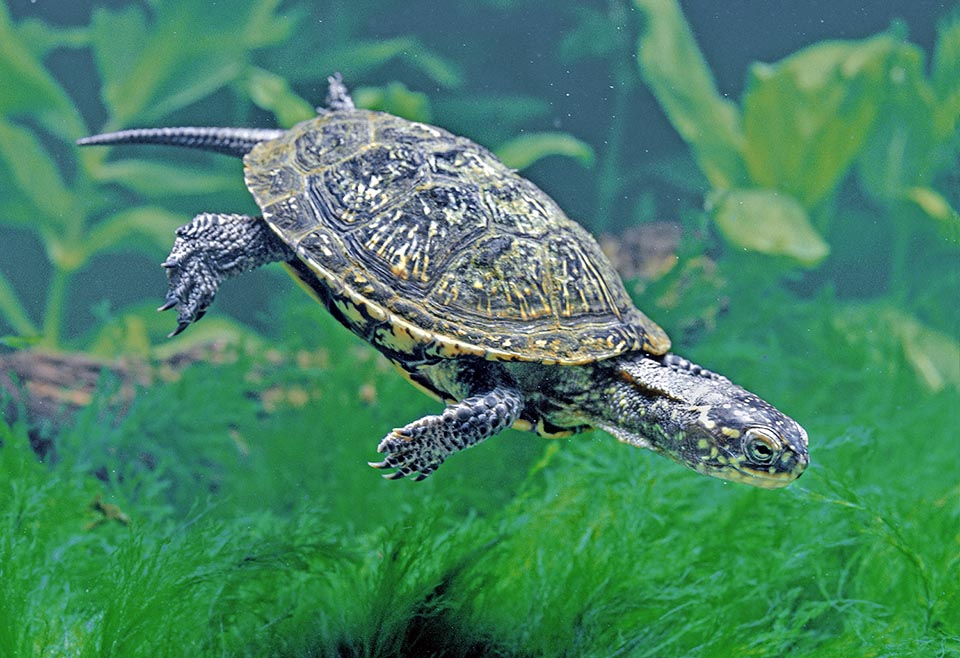
With 6 subspecies and several synonyms linked to the chromatic variability, Emys orbicularis grows in most Europe, Middle East and North Africa © Giuseppe Mazza
The European pond tortoise (Emys orbicularis, L., 1758), known also with the name of European pond terrapin, in reference to the overall shape of the body, is one of the very few species of Reptiles of the order of the Testudinata (Testudines), family of the Emydids (Emydidae), diffused also in the temperate zones of Asia Minor, north-western Africa and central and southern Europe.
The generic name originates from the old Greek “ἐμύς” (emys), freshwater turtle, whilst the specific term orbicularis means, rightly in Latin, round in shape.
Another water turtle of the family of the Geoemydids (Geoemydidae) present in the European continent is the Mauremys caspica, species with which the European pond tortoise coexists in the Iberian Peninsula and in the Balkans.
Zoogeography
Emys orbicularis, that occupies practically the whole distribution range of the genus, to which is ascribed only another species, endemic to Sicily (Emys trinacris), is divided in 7-8 races distinguishable on the basis of diagnostic elements, whose validity is still to be verified and in any case relegated in distinct fragmented geographical areas.
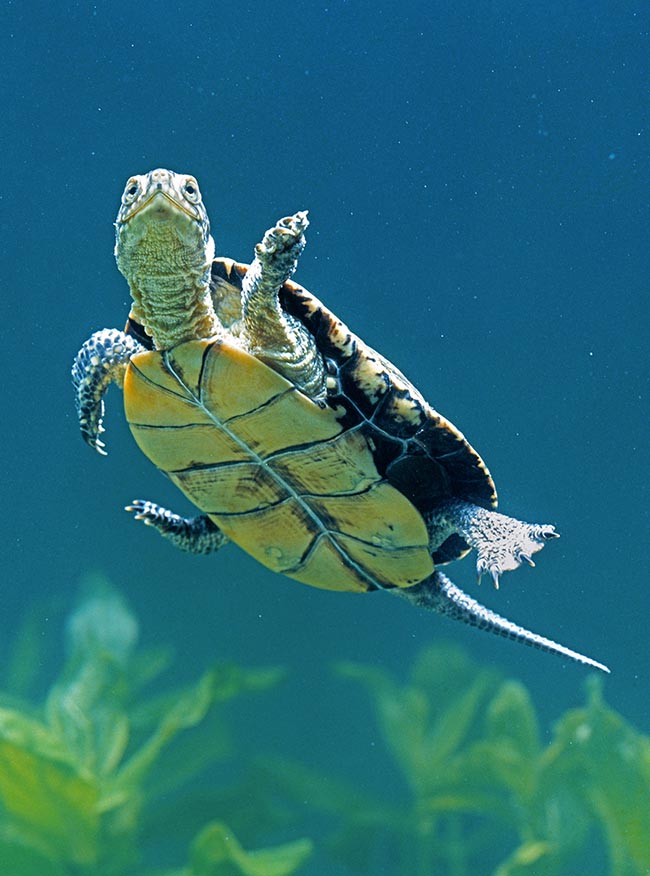
It can reach 25 cm and about 1 kg. The ventral shell, slightly concave in the males, is formed by 12 elements © Giuseppe Mazza
Specifically, whilst in central Europe is found the typical race to which is given the common name of European pond turtle (E. o. orbicularis), in Anatolia lives theTurkish pond turtle or Eiselt’s pond turtle (E. o. eiselti), in Greece the Hellenic pond turtle (E. o. hellenica), in the Iberian Peninsula and in North Africa the Western pond turtle (E. o. occidentalis), in the Middle East the Eastern pond turtle, known also as Persian pond turtle (E. o. persica), in north-western Italy the Ligurian pond turtle (E. o. ingauna).
Very common until a few centuries ago in the regions of central-southern Europe where it was hunted also for food purposes, nowadays this species has seen its range greatly reduced and is considered extinct in the regions located west of Elba Island.
The causes of this are to be sought mainly in the subtraction of natural habitats due to anthropic activities such as the increasing industrialization, the agricultural exploitation of land, the reclamation of wetlands with the regulation of the water courses and the suppression of riparian vegetation, the progressive pollution of the waters after the introduction of insecticides and herbicides.
Morphophysiology
Being small, the European pond tortoise may reach the length of 25 cm with a weight that in adults can slightly exceed the kilogram.
The body is variously coloured, most frequently dark or greenish and, especially in the southernmost populations, appears speckled with yellow on the carapace and on the not protected parts of the body. The legs, of the same colouration as the body, have toes united up to the base of the nails by an interdigital membrane. In both sexes, the tail has no terminal nail and in the adults measures about half of the overall length of the animal.
The ventral shell (plastron), usually slightly more concave in the males, has a variable colour, from that of the sand with scarce dark veins to the uniform yellow.
Typically, the plastron is composed of 12 elements and displays on its central part a transversal articulation that connects it to the dorsal shell by means of elastic ligaments that allow some mobility to the two parts of the plastron itself.
The dorsal shell (carapace), flat and with an oval shape, hence the specific name, is very varied in colour, from brown to olive green, up to black. It is formed by 5 horny vertebral plates, 8 costal (4 per side) and 25 marginal, of which one nuchal and one caudal split in two parts. In the young specimens on the dorsal shell is present a central keel that later on, with the growth, disappears completely.
The sexual dimorphism begins to get more evident around the 5 years of age and concerns few morphological characters linked to the reproductive activity.
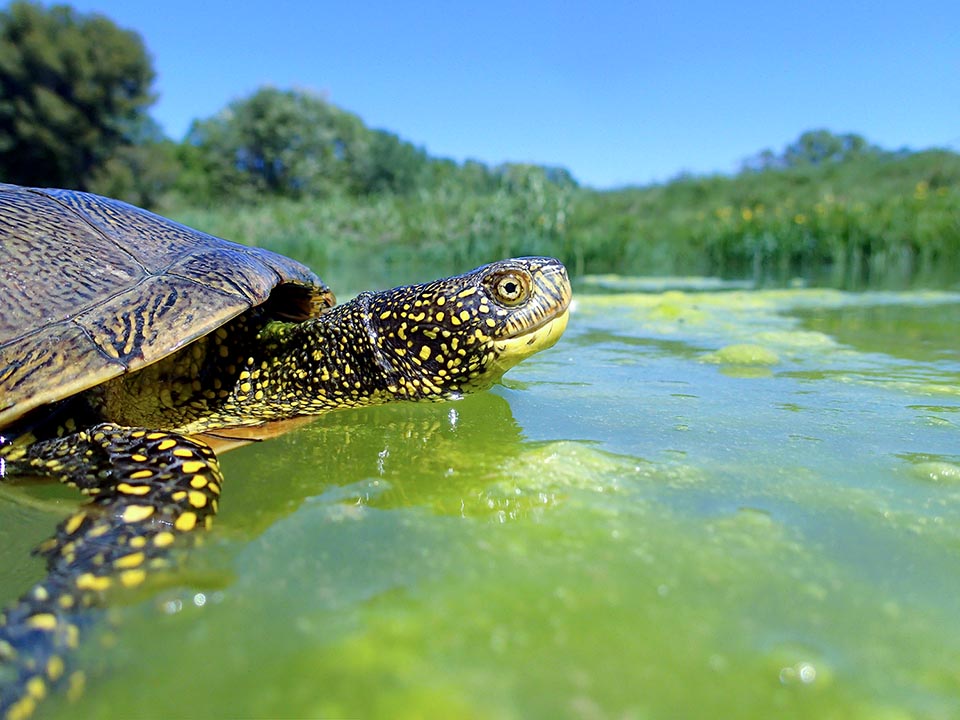
Though strictly linked to water, compared to other aquatic turtles, the European pond tortoise is not a good swimmer © Cédric Roy
In the females the tail is shorter than in the males with the base wider in relation to egg laying, whilst in the males the ventral shell is convex and the nails of the forelegs are very arched, suitable for hooking up the carapace of the females during the mating.
Ecology-Habitat
Essentially a marsh animal and lover of the high temperatures, the European pond tortoise lives preferably in calm and limpid environments of freshwater with the banks rich in vegetation.
It may be found also in the brackish waters of coastal lagoons and mouths of rivers and even in artificial environments such as irrigation channels and ponds in the city parks.
Unlike other species of aquatic turtles, Emys orbicularis is not a good swimmer, even if strictly linked to the aquatic environment where it spends most of the vital circle and from which it gets away with great caution.
During the day this tortoise hides among the riparian vegetation of ponds and bodies of water.
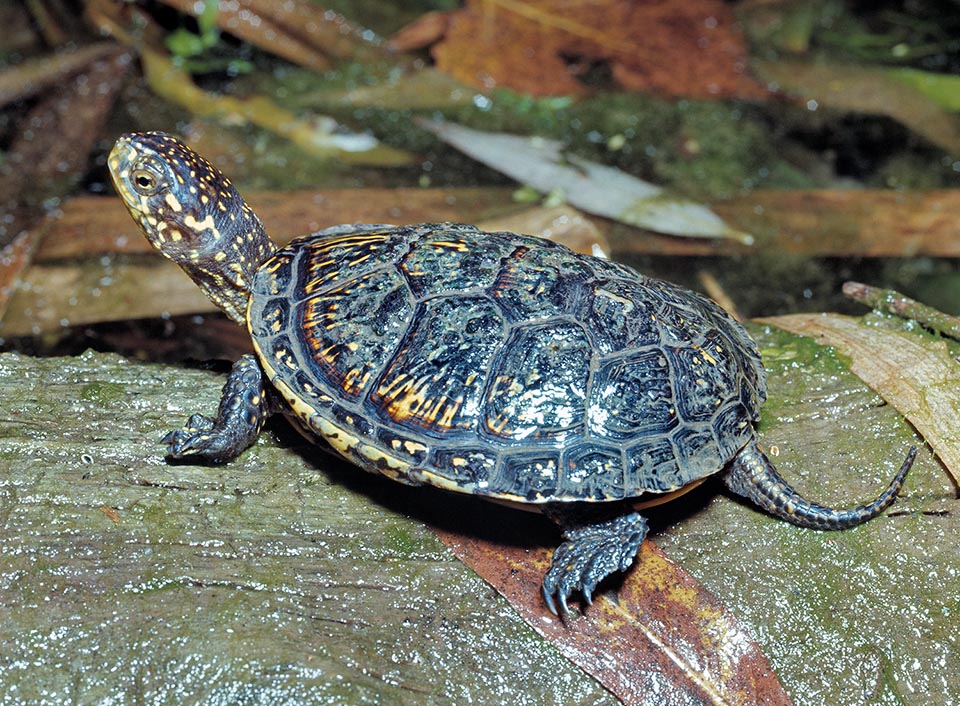
Active by night, in calm and clear waters rich in vegetation but also in brackish mouth of rivers, Emys orbicularis is a mainly carnivorous species. It eats insects larvae, worms, snails, tadpoles, adult amphibians and small fishes, including the dead ones, carrion of animals and various aquatic plants such as water lilies and duckweed © Giuseppe Mazza
Mainly carnivorous animal, becomes active during the night hours and goes around looking for various prey, mainly formed by larvae of insects, worms, snails, larvae and adults of amphibians and small fishes; it eats also dead animals or carrion of other animals and even aquatic vegetation, such as water lilies and duckweeds. Despite its voracity, Emys orbicularis does not create any damage to the marshy biocenosis and can survive even several years without feeding.
In autumn, the European pond tortoise moves to the muddy bottom of the water of ponds and lakes, where it hides and overcomes winter rigidities remaining hibernated until the following spring; in this period the physiological functions of the animal are very reduced and the need for oxygen is ensured by the quantity absorbed through the skin breathing and the cloaca. The period of hibernation ends when the temperature of the water reaches at least 10 °C.
It has been noted that in some cases, instead of water but always close to the same, individuals of this species take shelter in a den they dig in the soil or among the roots of the vegetation, or among the rocks.
In the warm climate regions, like the African ones, the European pond tortoises stay active all year round and when the intense summer heat dries up the body of water where they live, they suspend their activity and look for shelter in their den waiting for the rains.
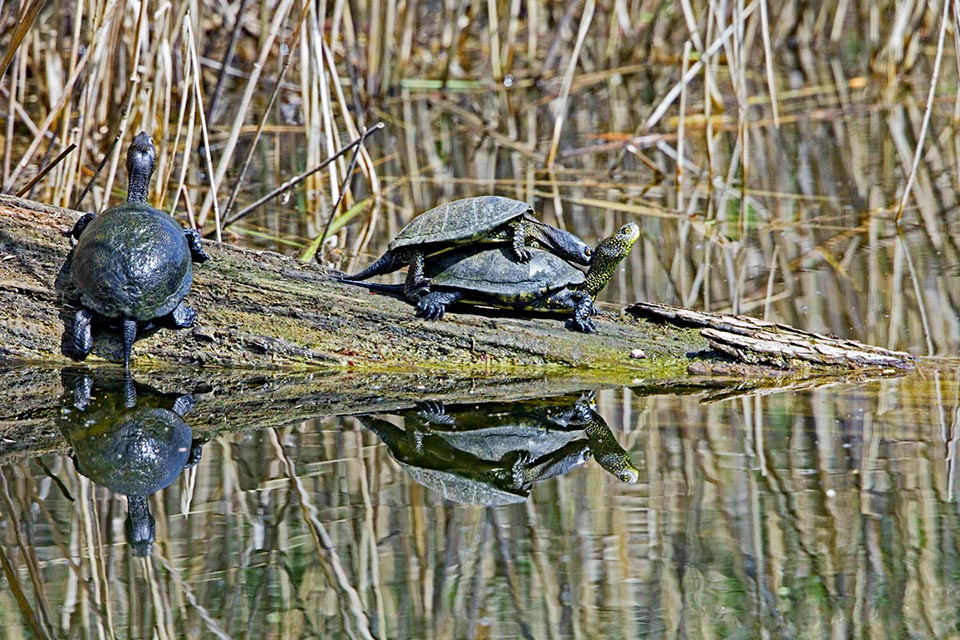
While mating the males immobilize the females with their convex ventral shell and the arched nails of the forelegs that hook its carapace © Eric Chevalier
Ethology-Reproductive Biology
In late spring or in early summer, comes the time of the mating season during which among the males that get particularly aggressive, clashes can take place, in any case not bloody.
Matings can happen in a water environment as well as on the mainland; the females can lay fertile eggs even two years after the mating.
About 30-45 days after mating, the females go looking for a suitable place for laying the eggs, sometimes getting far even some kilometres from their own site where they usually live.
Once found it, each female digs with the hind legs a hole in the sandy soil and lays there 4 to 12 roundish eggs having a hard white shell that she covers with dry sand.
After a period that, depending on the latitude, may vary from 80 to 90 days, up to more than 120 days in northern Europe, the babies are born, equipped with an “egg tooth” they utilize for breaking the shell and that will disappear once the function is done.
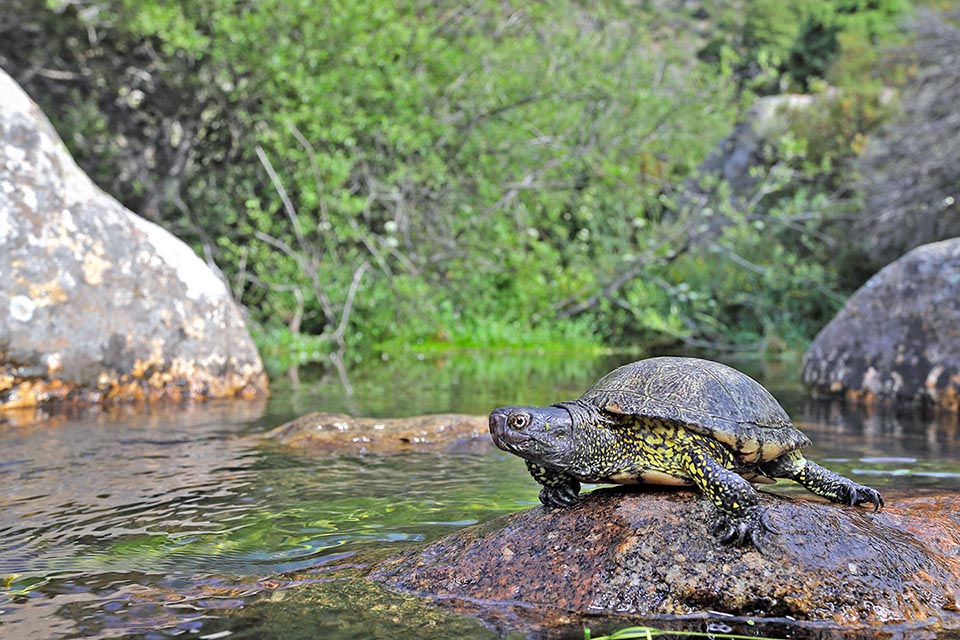
30-45 days after mating, the females look for a sandy bottom, not subjected to floodings, for laying 4-12 eggs in a hole dug with the hind legs © Fernando Iglesias
At birth, the babies have the body of dark brown colour dotted with yellow, are provided of a soft and keeled armour and weigh less than 10 g. In the cases the temperature is not warm enough or of late oviposition, the hatching may take place on the spring successive to that of the spawning.
As it happens in many species of reptiles, the sex of the newborns is determined by the temperature of incubation. With constant temperatures between 27 and 29 °C, come to life babies of both sexes; conversely, with temperatures varying between 23 and 27 °C only males come exclusively to life, whilst with temperatures keeping between 29.5 and 33 °C only females will be born.
Unlike the adult specimens that practically do not have natural predators, the young born up to a couple of years of age may be predated by aquatic birds and by fishes. The growth is very slow and lasts even up to 30 years. Unlike the males that reach the sexual maturity when 6-8 years old, the females become mature only when 15. Very long-lived animal, the European pond tortoise is not hurried and can even exceed 120 years of age.
Finally, we must not forget that, relegated to Sicily, where it is present with isolated populations mostly concentrated on the northern side of the island, live the other species of the genus, the Sicilian pond turtle (Emys trinacris, Fritz et alii, 2005).
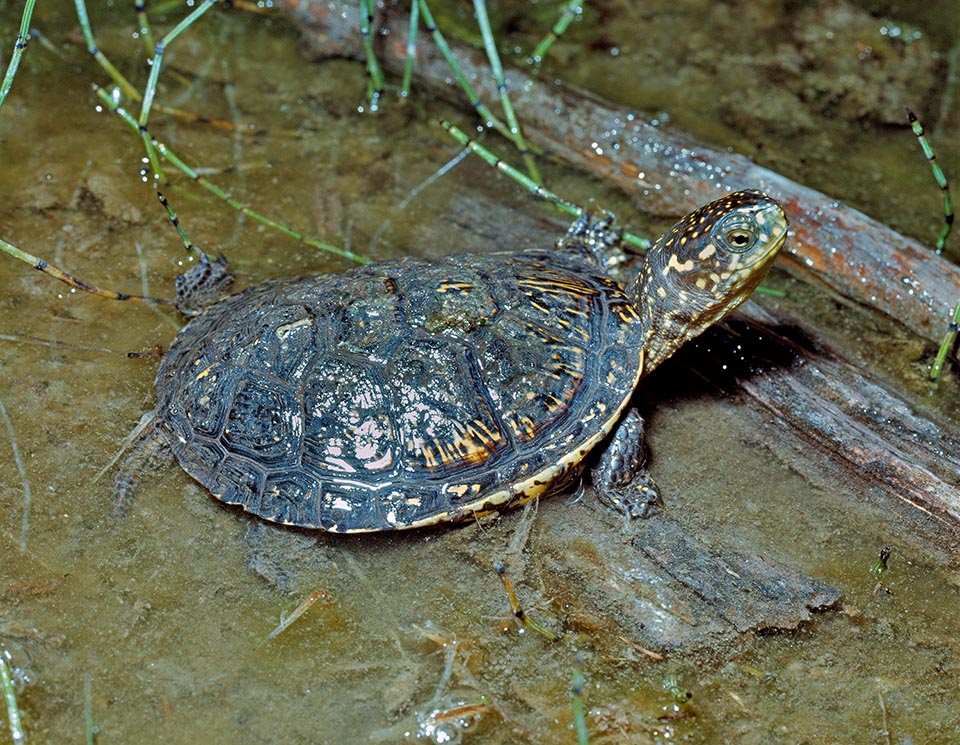
Incubation lasts 80-90 days, but even more than 120 days or one year if cold arrives. In the young specimens on the dorsal shell is present a central keel that later disappears completely while growing. The mortality is high during the first two years of life, but the life expectancy of European pond tortoise is 120 years © Mazza
About this, we must specify the fact that the Sicilian populations in the past were attributed to one race of the European pond tortoise named Emys orbicularis galloitalica and that only recently, based on recent biomolecular studies, they have been raised to the status of species in itself.
From the morphological point of view, this species distinguishes from the European pond tortoise for some chromatic characteristics, such as those of the plastron that in the Sicilian species has no brown streaks and for the activity that is mainly diurnal.
Concluding, the chromatic variations, not infrequently accentuated, that the populations of Emys orbicularis manifest in the various geographical districts of the range of the species, most likely in the past have misled several specialists who have attributed taxonomic importance to it. From this the high number of species deemed in themselves and presently brought back in synonymy of Emys orbicularis.
Synonyms
Here are some: Testudo lutaria (Linnaeus, 1758), Testudo europaea (Schneider, 1783), Testudo punctata (Gottwald, 1792), Testudo rotunda (Merrem, 1820), Emys antiquorum (Valenciennes, 1833), Emys hofmanni (Fitzinger, 1836) and Emys tigris (Salvator, 1897).
→ For general notions about Testudines please click here.
→ To appreciate the biodiversity within the TURTLES please click here.
